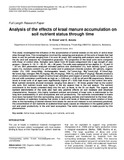| dc.description.abstract | This study investigated the influence of the accumulation of animal wastes on the soils of active kraal sites through time. This investigation involved the sampling and analysis of the soils of kraals that had been in use for periods ranging from 2 to over 45 years. Soil sampling and analysis were done both in the dry and wet seasons for comparative purposes. The properties of the kraal soils were compared with those of control sites. Samples were taken from 25 kraals categorized into 5 age (length of use)
groups: < 5years; 6 - 10; 11 - 20; 21 - 40; > 40 years. The soils were sampled at two depths, 0 – 15 and 15 – 35 cm. Soil parameters analyzed included particle size distribution (%), bulk density (g/cm3), pore
space (%), moisture content (%), pH in water and in potassium chloride solution, EC (μS/cm), organic
matter (%), CEC (meq/100g), exchangeable bases: Ca++(cmolc/kg), Mg++(cmolc/kg), K+(cmolc/kg),
Na+(cmolc/kg); nitrogen: NH4-N (mg/kg), NO3-N (mg/kg), TKN (%), and Olsen P (mg/kg). Results showed a direct correlation between length of active kraal utilization and impact of animal waste concentration on
the soil with correlation coefficients as high as r = 0.99 and r = 0.95 for pH and OM respectively. Nutrient levels in kraal soils of all ages were significantly higher (P = 0.05) than those of the control site soils.
Most nutrient elements showed increases ranging from about 2 - 30 times greater than in the control
site soils. Soil nutrient levels were higher in the dry season than in the wet season. The nutrient enrichment in the kraals extended deep into the soil, at least, to the 35 cm depth. The organic and
nutrient enrichments of the soils also had very positive effects on soil moisture and structural
characteristics. However, this highly localized nutrient enrichment of kraal soils is detrimental to the
long term sustainability of arid ecosystems and soil productivity. The nutrients concentrated in kraals have been harvested from the surrounding areas by grazing animals and transferred to the kraal sites.
In a situation of sedentary kraaling that exists in semi arid lands of Botswana where rotation of kraal
sites or the harvesting of animal manure from kraals for use as soil manure is not commonly practiced,
the concentration of soil nutrients at scattered kraal spots causes an imbalance in the spatial pattern of
soil and plant productivity in the arid land ecosystem. The entire ecosystem is made poorer by this
phenomenon. | en_US |

